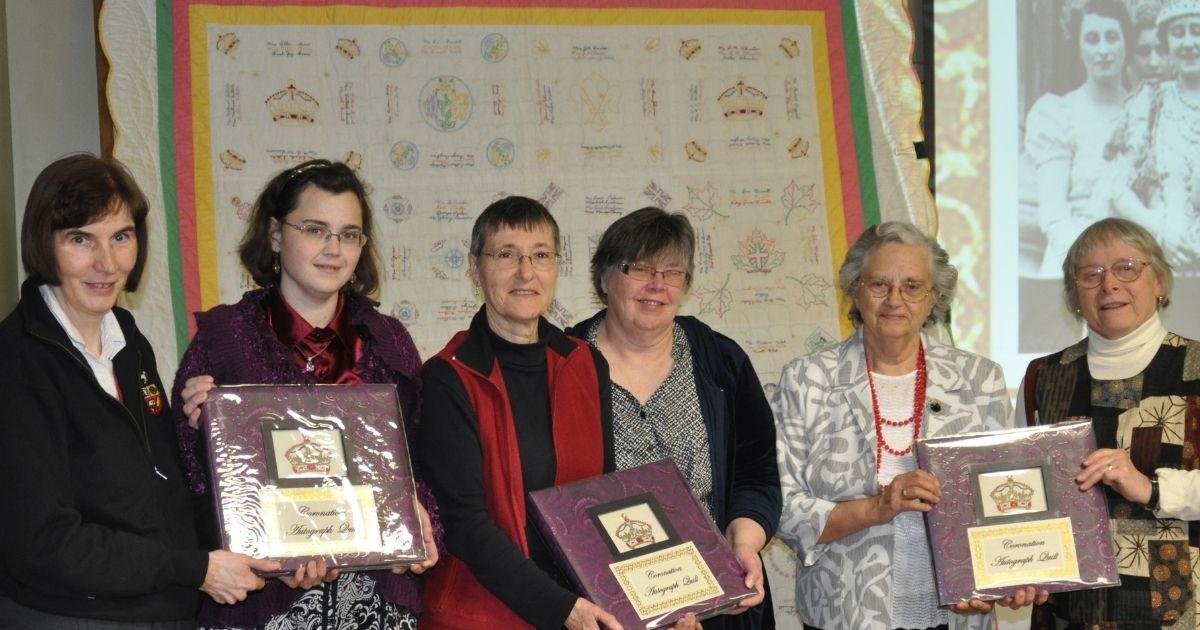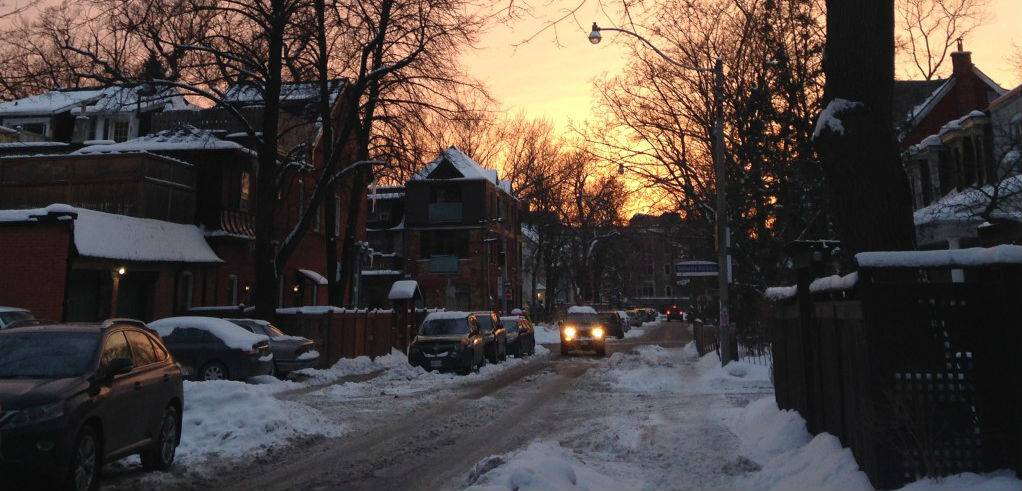Quilts can be an integral part of world events, community history and family lore all at the same time. This is the story of the 1937 Coronation Autograph Quilt that was created by women residing in a tiny community called Klondyke in Essex County, Ontario. My heirloom ‘Coronation Autograph Quilt’ was inspired by the Coronation of King George VI and Queen Elizabeth. It chronicles the families of the community that put their hands, hearts and talents together to design and create the quilt. It also records the story of my family at that time.
World Event – 1937
The year 1937 was but one year in the seemingly endless World Depression. Canada’s population was just over eleven million and the average household income was $1,700.00 per year and one dollar in 1937 would equal $17.25 in 2019. ‘Folding money’ became bilingual in Canada for the first time. A loaf of bread cost nine cents and milk was fifty cents a gallon, both delivered to the doorstep. A new car cost about $600 to $700 and gas was twenty cents per gallon. A new home cost about $6000. Another staple of daily life in the 1930’s was the Eaton’s catalogue. Almost anything could be ordered that one needed, for home, garden and farm. Parcels came by regular post, and larger items arrived by train. Hydro lines had just been installed down the rural concessions in 1930’s. Telephone communication was almost exclusively on a ‘Party’ line, so keeping up with the neighbour’s news was never easier. At the movies, for about 25 cents you could see Disney’s first animated feature ‘Snow White’. Shirley Temple Dolls enchanted little girls, while little boys were playing with sets of Tinker Toy and Lionel Electric Trains. In the news Amelia Earhart and her plane were lost at sea. The film news of the Hindenburg disaster was tragically spectacular. The world’s first blood bank opened in Chicago. Medical news was not good in Ontario as 2546 cases of Polio were reported. J. R. Tolkien published ‘The Hobbit’, John Steinbeck wrote ‘Of Mice and Men’ and Lucy Maud Montgomery gave us her last book ‘Jane of Lantern Hill’. April 1937 saw the second most devastating flood of the Thames River here in southwestern Ontario from St. Marys to London through Chatham and along its journey to Lake St. Clair. Many lives were lost and property damage was immense. Seven thousand people were left homeless in London alone.
The Coronation of King George VI and Queen Elizabeth was a welcome respite to the relentless Depression. Many people seized the exciting opportunity for a celebration as there was little joy at the time. Around the Empire coins and medals were struck, postage stamps were issued, poetry was written, magazine articles were prepared and books were published about the King and Queen and their family histories. The significance and importance of every detail of the ceremony was highlighted as it would unfold on May 12th in Westminster Abbey. Programs survive from the Coronation, and from what seem to have been simultaneous events, almost re-enactments of the ceremony all over the globe. Every type of celebration or festival known to man was planned in honour of the event and when you look at photos from that time, it was much more of a carnival atmosphere at times than one would imagine. Celebrations such as huge street parties continued for hours and the streets themselves seemed to celebrate with rows of red, white and blue bunting on buildings, along with flags, streamers, banners and all sorts of patriotic decorations. That evening whole streetscapes were lit with millions of lights.
Short History of Quilts
Here in Canada, excitement and creativity were everywhere long before the event on May12th. I am not an expert on either the Coronation of Kings or the art of quilting, but these two things came together in a tiny Essex County community in 1937. My ‘Coronation Autograph Quilt’ is a wonderful example of this kind of creativity. The ‘Coronation Autograph Quilt’ was made by the women of St. James Anglican Church, Grainger, and some of their friends in Gosfield South Township, Essex County, between April and December of 1937. The Coronation quilt is classified as a Fundraiser and Autograph or Signature quilt, with the proceeds given to the Anglican Young People’s Association of the church after it was sold at auction. Autograph or Signature quilts have been popular off and on since the mid nineteenth century. They were widespread about the time of the Civil war (1860-1864) in the United States. There are Fundraiser quilts too, and the price has varied over the years for having your name included. Sometimes the names of whole congregations are recorded on a quilt as a community fundraiser or maybe a gift for a departing minister. National, provincial and local dignitaries and businesses are usually included in the list of names on some quilts as a courtesy, historical record or in recognition of their support of the project. There are several types of Autograph or Signature quilts. Some have copies of the person’s actual signature, and some have all the names in one handwriting on each block, such as the Coronation Quilt. Others had no fee, and the people named may or may not have given permission to be included. A few of these quilts can be found in various museums around the countryside, while many have disappeared over the years along with whatever records, stories and possibly even secrets they held. When they are available, these quilts are used by family tree and local history researchers in their work, and are said to be very helpful in identifying family groups within communities.

(Photo Courtesy of Kingsville Archives)
St James Anglican Church, Grainger, at Klondyke was a tiny satellite congregation of the Church of The Epiphany (Anglican) in Kingsville. It was very plain inside and out, but served the needs of many of those living along the 4th, 5th and 6th concessions in Gosfield South Township. It was within walking distance for many of these families. There were the usual annual celebrations including Christmas Concerts staged by the Sunday School children that were witnessed and enjoyed every year. I believe there were only ever 3 weddings there. The milestone events of church life such as baptisms, confirmations and marriages were usually celebrated in Kingsville at Epiphany. A one room school house was across the corner from the church. Long ago now, the church was moved to a nearby farm and is a small farm shed, and the school house is a private home.
Family Lore
My Grandmother’s diaries are an amazing account of everyday life in the 1930s I found this entry in her diary: “April 30, 1937: “Ben & Garnett fixed fence on the 6th [concession]. I sat in car and embroidered quilt block (Coronation quilt). Then Ben and I went to Cottam. Herb Shaneyfelt here for stones and potatoes.” The daily comings and goings of family members and community ‘callers’ are noted, and who borrowed the shovel or pruning snips, and then returned them, are routinely recorded. The weather was a concern for farmers so it was often logged, and also a road trip to Thamesville to see the devastating spring flooding I mentioned above. There are at least 16 references to the Coronation Quilt in my Grandmother’s diary.
Work on the embroidery for the quilt began in April 1937. My Grandmother did the centre two blocks which were not in the patterns supplied so she drew the intricate silhouette of the King and Queen in profile which makes my quilt unique. My grandmother drew other blocks too – the Shamrock and possibly parts of the Maple Leaf block. In May meetings were held about the project and the blocks were all distributed to the ladies to embroider. The embroidered blocks depict St. Edwards Crown, the Bowes-Lyon family crest of Queen Elizabeth, a Greek Cross, the Maple Leaf, the Shamrock, the Scottish Thistle, the Scepter and Orb, the Unicorn, the Lion, the Imperial State Crown, the Ampulla, a Fairy, and a few other items related to the Coronation. The motif embroidery work, along with the painstaking embroidering of the names in delicate ‘outline’ stitch was completed in early fall, and the donations for the names were collected. In addition to the pictures on the quilt there are either twelve or sixteen names embroidered on each block for the princely sum of five cents a name.
Most of the names on the quilt were of the friends and families of the ladies who made it. Not everyone was keen to have their name embroidered on the quilt, and my great grandfather was one of these. If you look closely at the Maple Leaf block you can see Mom and her parents, her aunt Maude
and her husband and her Uncle John and his wife and her grandmother’s name Mrs. W. H. McAlister. However her grandfather, a slightly stubborn old Scot, decided for some unknown reason, did not want his name on the quilt. He paid for his wife, Mom’s grandmother, ‘Mrs. W. H. McAlister’ written on one line and the name ‘Collie’ beneath it. I expect this is the only example of a family pet/farm dog’s name on an Autograph quilt anywhere in the Dominion.

(Photo Nancy West)
My Mother, Betty (Cowell) Henderson was a little girl of nine when the quilt was sewn, too young to help out with the handwork, but she had a daily look at it, as the work progressed. Several of the ladies of the church and local community worked the embroidered blocks. Next the blocks were set together
by my Grandmother, Laura (McAlister) Cowell, using a treadle sewing machine. A colourful border of yellow, pink and green surrounds the quilt blocks and a scalloped binding completes the design layout. The quilting took place in Grandma’s living room out on Concession 5. Each block’s motif has some connection to the Royal Family, the Coronation or the Commonwealth. My Mother remembered the quilt pattern was mail ordered but we had no idea of its origin.



| Three of my favourite blocks are shown here (L-R): the St. Edward’s Crown, the Unicorn & Westminster. (Photos Nancy West) |
Another detail Mom remembered was the thread for the embroidery and quilting was donated by the Coates and Clark Co. One of the boxes the thread came in survives along with part of one sheet of embroidery transfers.

(Photo Nancy West)
The women from the small community in Essex County made the quilt a priority, and got it finished in record time, in between all the gardening, canning and the usual intense summer work of getting ready for the next winter. The quilting was finished on Novemberninth and Grandma and my Aunt completed the binding on November eighteenth. The Coronation Quilt was showcased prior to the auction in Quick’s store window in Kingsville for a few days and in the Mercantile store window in Cottam. Perhaps a few other store windows also displayed it.


Vintage photos of Cottam Mercantile Store Front, Cottam, Ontario (Lt) and Quick’s Dry Goods Store (with awnings), Kingsville, Ontario, on right side of intersection (Rt). (Photos courtesy of Kingsville Archives 2019)
The Coronation Quilt was sold at auction for twenty dollars to Mr. and Mrs. Herb Shaneyfelt at a highly anticipated social event in the Odd Fellows Hall in the village of Cottam on December 1, 1937. Mrs. Shaneyfelt was one of the embroiderers and quilters on the project. My Mother, went home with her parents a very disappointed young lady, because her Dad, Ben Cowell had only bid nineteen dollars.

After the auction on that December night, the quilt disappeared from our midst for almost forty years, gone but not forgotten. A few months after Mrs. Shaneyfelt passed away in 1974, Mom wrote to Mr. Shaneyfelt to see if he still had it, and what his plans were. He still had the quilt and after some discussions about its fate and the price, my Mother agreed to pay seventy-five dollars for it.
Mr. Shaneyfelt was pretty crafty in his reply to Mom’s letter of inquiry, telling Mom to consider how much it would mean, not only to her, but to her children and grandchildren. After we brought it home, we admired it and talked about the pictures and the names. Most of the motifs are obvious in their relationship to the Coronation. Westminister Abbey, St Edward’s Crown, the Shamrock, Thistle and Maple Leaf are clear, but the Fairy had us stumped. Then the quilt was then stored away in Mom’s cedar chest.
When I was married, Mom gave me the choice between her 3 best quilts and I chose the Coronation Quilt. It came to reside in my cedar chest. I took it out occasionally and displayed it at various events in the area. Then I read about a Heritage Quilt Show being held in Exeter in March 2011. I contacted the organizers and asked if they would like to include the Coronation Autograph Quilt in their show … they said yes. When I arrived at the show I asked Judy Lyons, a qualified quilt appraiser to look it over. Judy said “I feel this quilt is of Outstanding Significance and National Importance. It has a close association with an event that connected Canada and Britain during a specific time in Royal history. It has a large amount of recorded genealogy for the region. The aesthetic qualities are excellent. It adds to the value of the study of the arts.” Everyone loved the quilt, and inquired if I would mind having an article written about it. I agreed to have an article about my quilt written for the Canadian Quilter magazine, but first I wanted to get the answers to some of our questions about it.
Research
Since we knew the pattern was mail-ordered, I started looking into all the sources for patterns published at that time. A google search yielded no results. I contacted Simplicity, Vogue, McCalls and Butterick in the United States to see if the original pattern was in their archives, no luck there. My Grandmother’s clipping box had a quilt block pattern advertisement from the Canadian Countryman magazine. We remembered that Mom had completed another quilt from published quilt block patterns in the Family Herald. I contacted the Kingsville archives, and they found the original tiny newspaper clipping notice about the quilt auction, but nothing more. I next emailed Agriculture Canada Archives in Ottawa. They mentioned that I could see the same archives I needed much closer to home, at the University of Western Ontario. Upon further investigation, I was directed to find all the journals I was looking for at the University of Guelph. I spent a very interesting morning searching at the University of Guelph Archives, looking through the Farmer’s Advocate, Canadian Countryman and The Family Herald and Weekly Star. The great ‘Origin of the Pattern Mystery’ was solved that day, and I was elated when I found the advertisement and article in the March 24th 1937 edition of The Family Herald and Weekly Star. The librarians helped me make copies of the page. The article provided another answer too … the Fairy is the ‘Fairy Princess’ and alludes to Princess Elizabeth but there is no further explanation about the reference. The advertisement tells us that there were fifty coronation motifs, two sizes of each design. The accompanying description says these Coronation themed designs were for any article of clothing or linens but the possibility of quilt blocks was not mentioned. This likely makes the quilt one of a kind, worldwide. The Family Herald Pattern Department would send all the embroidery transfers, postage paid for fifteen cents. Twelve skeins of embroidery floss, could be ordered in special Coronation colours for forty cents. …. not forty cents each and postage was included! On the same page there was a little note about the embroidery work going on in England at the Royal Needlework School in preparation for the Coronation. As an aside, I noted as I flipped through the magazines there was already discussion of global warming trends in 1937.
After thinking it over and talking with Mom about who was related to whom on the quilt, I decided I should make a record for the Kingsville archives. I have never been a ‘scrapbooker’ but decided that would be the best way to share my quilt, its beautiful workmanship and story without actually giving it away! I prepared several detailed scrapbooks, and gave a talk to the local history group in Kingsville, and presented three of these scrapbooks to a genealogical library in the village of Essex, the Kingsville Archives, and the Church of the Epiphany in the spring of 2013.

Following the donation of the scrapbooks (2013), in the spring of 2014 Mom and I made another trip to the Kingsville area to meet with some of the descendants and other people still alive who are named on the Coronation Quilt. We compiled an index with everything we knew about the people listed, such as who their parents were, who they married, who their children were, and also the names of their siblings. At the present time (2019) there may only be about three or four people left who are named as children on the quilt. Recently I have been using internet resources and cemetery records to try to include birth and death dates with the names on the quilt, as a reference for future researchers.
The Coronation Autograph Quilt is one of my greatest treasures, as it tells a wonderfully interwoven story, truly a snapshot in time of my family, the community where they lived and a world event in the Coronation of King George VI and Queen Elizabeth.

Contact Information:
Nancy West
nwest@quadro.net














